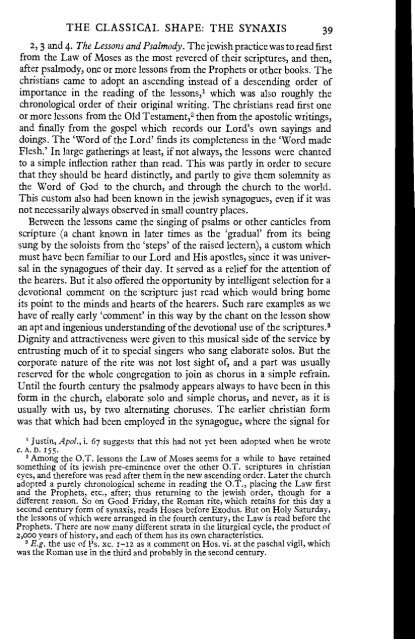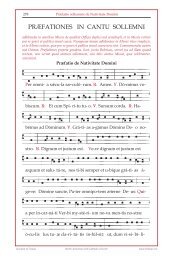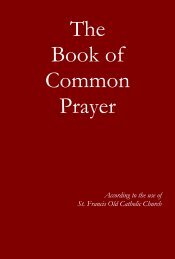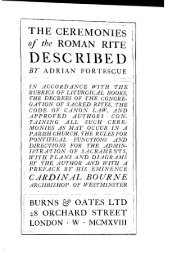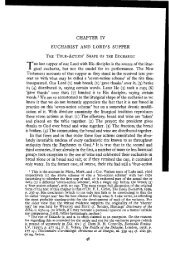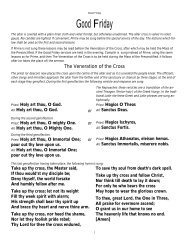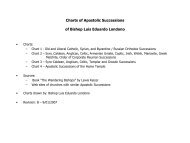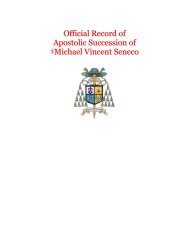The Shape of the Liturgy; Chapter III
The Shape of the Liturgy; Chapter III
The Shape of the Liturgy; Chapter III
Create successful ePaper yourself
Turn your PDF publications into a flip-book with our unique Google optimized e-Paper software.
THE CLASSICAL SHAPE: THE SYNAXIS 39<br />
2, 3 and 4. <strong>The</strong> Lessons and Psalmody.<strong>The</strong> jewishpractice wasto read first<br />
from <strong>the</strong> Law <strong>of</strong> Moses as <strong>the</strong> most revered <strong>of</strong> <strong>the</strong>ir scriptures, and <strong>the</strong>n,<br />
after psalmody, one or more lessons from <strong>the</strong> Prophets or o<strong>the</strong>r books. <strong>The</strong><br />
christians came to adopt an ascending instead <strong>of</strong> a descending order <strong>of</strong><br />
importance in <strong>the</strong> reading <strong>of</strong> <strong>the</strong> lessons,! which was also rougWy <strong>the</strong><br />
chronological order <strong>of</strong> <strong>the</strong>ir original writing. <strong>The</strong> christians read first one<br />
or more lessons from <strong>the</strong> Old Testament,2 <strong>the</strong>n from <strong>the</strong> apostolic writings,<br />
and finally from <strong>the</strong> gospel which records our Lord's own sayings and<br />
doings. <strong>The</strong> 'Word <strong>of</strong> <strong>the</strong> Lord' finds its completeness in <strong>the</strong> 'Word made<br />
Flesh.' In large ga<strong>the</strong>rings at least, ifnot always, <strong>the</strong> lessons were chanted<br />
to a simple inflection ra<strong>the</strong>r than read. This was partly in order to secure<br />
that <strong>the</strong>y should be heard distinctly, and partly to give <strong>the</strong>m solemnity as<br />
<strong>the</strong> Word <strong>of</strong> God to <strong>the</strong> church, and through <strong>the</strong> church to <strong>the</strong> world.<br />
This custom also had been known in <strong>the</strong> jewish synagogues, even ifit was<br />
not necessarily alwaysobserved in small country places.<br />
Between <strong>the</strong> lessons came <strong>the</strong> singing <strong>of</strong> psalms or o<strong>the</strong>r canticles from<br />
scripture (a chant known in later times as <strong>the</strong> 'gradual' from its being<br />
sung by tlle soloists from <strong>the</strong> 'steps' <strong>of</strong> <strong>the</strong> raised lectern), a custom which<br />
must have been familiar to our Lord and His apostles, since it was universal<br />
in <strong>the</strong> synagogues <strong>of</strong> <strong>the</strong>ir day. It served as a relief for <strong>the</strong> attention <strong>of</strong><br />
<strong>the</strong> hearers. But it also <strong>of</strong>fered <strong>the</strong> opportunity by intelligent selection for a<br />
devotional comment on <strong>the</strong> scripture just read which would bring home<br />
its point to <strong>the</strong> minds and hearts <strong>of</strong> <strong>the</strong> hearers. Such rare examples as we<br />
have <strong>of</strong> really early 'comment' in this way by <strong>the</strong> chant on <strong>the</strong> lesson show<br />
an apt and ingenious understanding <strong>of</strong> <strong>the</strong> devotional use <strong>of</strong> <strong>the</strong> scriptures. 3<br />
Dignity and attractiveness were given to this musical side <strong>of</strong> <strong>the</strong> service by<br />
entrusting much <strong>of</strong> it to special singers who sang elaborate solos. But <strong>the</strong><br />
corporate nature <strong>of</strong> <strong>the</strong> rite was not lost sight <strong>of</strong>, and a part was usually<br />
reserved for <strong>the</strong> whole congregation to join as chorus in a simple refrain.<br />
Until <strong>the</strong> fourth century <strong>the</strong> psalmody appears always to have been in this<br />
form in <strong>the</strong> church, elaborate solo and simple chorus, and never, as it is<br />
usually with us, by two alternating choruses. <strong>The</strong> earlier christian form<br />
was that which had been employed in <strong>the</strong> synagogue, where <strong>the</strong> signal for<br />
1 Justin, Apol., i. 67 suggests that this had not yet been adopted when he wrote<br />
C.A.D.I55·<br />
2 Among <strong>the</strong> a.T. lessons <strong>the</strong> Law <strong>of</strong> Moses seems for a while to have retained<br />
something <strong>of</strong> its jewish pre-eminence over <strong>the</strong> o<strong>the</strong>r a.T. scriptures in christian<br />
eyes, and <strong>the</strong>refore was read after <strong>the</strong>m in <strong>the</strong> new ascending order. Later <strong>the</strong> church<br />
adopted a purely chronological scheme in reading <strong>the</strong> a.T., placing <strong>the</strong> Law first<br />
and <strong>the</strong> Prophets, etc., after; thus returning to <strong>the</strong> jewish order, though for a<br />
different reason. So on Good Friday, <strong>the</strong> Roman rite, which retains for this day a<br />
second century form <strong>of</strong> synaxis, reads Hosea before Exodus. But on Holy Saturday,<br />
<strong>the</strong> lessons <strong>of</strong> which were arranged in <strong>the</strong> fourth century, <strong>the</strong> Law is read before <strong>the</strong><br />
Prophets. <strong>The</strong>re are now many different strata in <strong>the</strong> liturgical cycle, <strong>the</strong> product <strong>of</strong><br />
2,000 years <strong>of</strong> history, and each <strong>of</strong> <strong>the</strong>m has its own characteristics.<br />
• E.g. <strong>the</strong> use <strong>of</strong> 1's. xc. 1-I2 as a comment on Hos. vi. at <strong>the</strong> paschal vigil, which<br />
was <strong>the</strong> Roman use in <strong>the</strong> third and probably in <strong>the</strong> second century.


